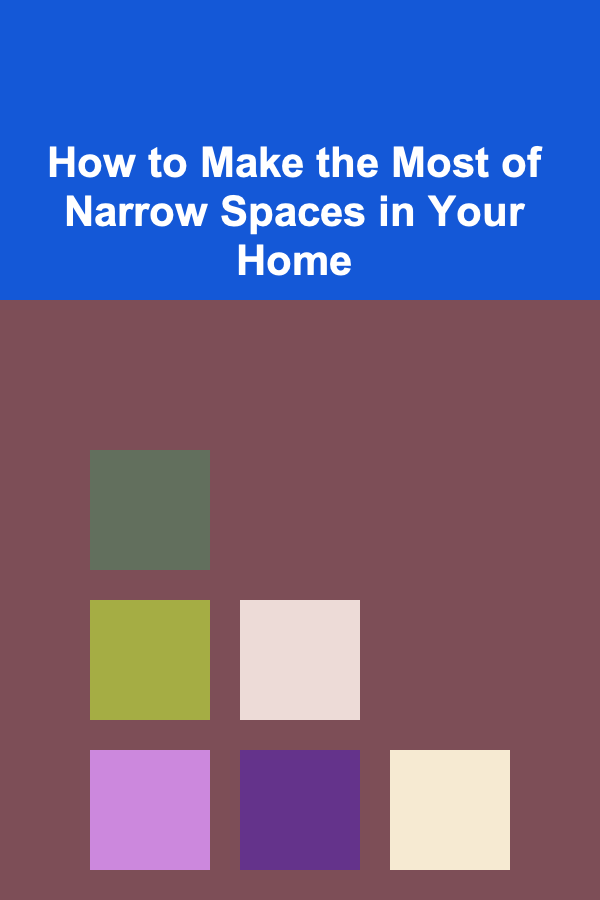
How to Make the Most of Narrow Spaces in Your Home
ebook include PDF & Audio bundle (Micro Guide)
$12.99$9.99
Limited Time Offer! Order within the next:

Narrow spaces in homes often pose a unique challenge when it comes to interior design and functionality. Whether it's a long hallway, a cramped kitchen, or a narrow living room, maximizing these spaces can require creative thinking, smart furniture choices, and an understanding of how to manipulate scale and layout to create a space that feels open, organized, and stylish.
In this article, we'll explore strategies and tips for transforming narrow spaces into functional, aesthetically pleasing areas that feel more spacious, efficient, and comfortable. We will look into design principles, furniture selection, color schemes, and storage solutions, all tailored specifically for narrow or constrained areas in your home. Whether you're dealing with a tiny apartment or simply a specific narrow room, these ideas will help you utilize every inch to its full potential.
Understanding the Challenge of Narrow Spaces
Before diving into specific tips, it's essential to understand why narrow spaces can be tricky to work with. The primary concern with narrow rooms or hallways is that they often feel cramped and may lack flow, which can make a space feel smaller than it is. Narrow spaces tend to restrict how furniture can be arranged and can create an imbalanced atmosphere if not designed thoughtfully.
Narrow spaces often face these common issues:
- Limited Furniture Arrangement: With restricted floor space, it can be difficult to arrange furniture without creating a cluttered or obstructed feel.
- Poor Flow: In a narrow space, it's easy for the room to feel disconnected, especially if furniture or decorations block the natural flow of the space.
- Lack of Natural Light: Long, narrow rooms can sometimes struggle to get enough natural light, especially if windows are small or placed awkwardly.
Despite these challenges, narrow spaces offer some advantages, too. They can be more intimate, easier to clean, and, when designed correctly, can feel just as functional and welcoming as larger rooms.
Use Vertical Space Effectively
One of the best ways to make the most of narrow spaces is by thinking vertically. Rather than focusing on increasing the floor space, consider utilizing the height of the room. This approach can help you maximize storage, create visual interest, and improve the overall functionality of the space.
Wall-Mounted Shelves and Racks
Adding wall-mounted shelves is a simple yet effective way to use vertical space. Floating shelves can hold books, decor, or everyday essentials without taking up floor space. This keeps the room feeling less cluttered while offering you a place to store items. For narrow hallways or corridors, installing slim shelves or racks can create additional storage for keys, bags, or other small items.
Advantages:
- Maximizes Space: Vertical shelving helps you store items out of the way without sacrificing valuable floor space.
- Easy to Install: Wall-mounted shelves are easy to put in place and don't require extensive renovations.
- Stylish: Floating shelves or slimline racks add a contemporary look to narrow rooms.
Hanging Lighting
Rather than relying on bulky floor lamps or wide pendant lights, consider installing lights that hang from the ceiling or are mounted on the wall. Wall sconces, track lighting, or even hanging light fixtures can free up floor space while adding warmth and illumination. Hanging lights also create the illusion of height, which is a key factor in making narrow rooms feel more spacious.
Benefits:
- Saves Floor Space: Hanging light fixtures don't take up floor space, leaving the room open and uncluttered.
- Illusion of Height: Suspended lights draw the eye upwards, creating a sense of height and making the space feel larger.
- Increased Functionality: Light up narrow spaces with focused or ambient lighting without sacrificing floor space for lamps.
Opt for Streamlined Furniture
Furniture selection plays a significant role in maximizing narrow spaces. For small or narrow rooms, choosing furniture that is compact, multi-functional, and visually lightweight can make a big difference. The key is to focus on furniture that doesn't overwhelm the space but rather enhances its functionality.
Choose Narrow, Low-Profile Furniture
For living rooms, bedrooms, or dining areas in narrow spaces, low-profile furniture such as slim sofas, lightweight chairs, and narrow coffee tables are ideal. These pieces do not take up much visual space, and their streamlined designs prevent the room from feeling overcrowded.
Advantages:
- Creates Flow: Slim furniture allows for better traffic flow, making the space feel more open and usable.
- Maximizes Floor Area: Furniture that is low and narrow helps open up more floor space, giving the room a less cramped feel.
- Flexibility: Low-profile pieces can often be rearranged more easily, allowing you to adapt the room layout as needed.
Invest in Multi-Functional Furniture
In a narrow space, it's essential to make every piece of furniture count. Multi-functional furniture, such as a sofa that doubles as a bed, an ottoman with hidden storage, or a dining table with expandable leaves, can save space while providing the necessary functions.
Benefits:
- Space Efficiency: Multi-purpose pieces help you utilize every inch of the room, especially in homes where space is at a premium.
- Cost-Effective: Buying fewer pieces that serve multiple purposes can save you money while making your home more functional.
- Adaptability: As your needs change, multi-functional furniture can be adapted to suit different activities or layouts.
Create the Illusion of Space
Visual tricks are essential when working with narrow spaces, as they can help make the room feel more expansive. By using clever design techniques, you can make even the smallest rooms feel more open and airy.
Use Light Colors and Reflective Surfaces
Light, neutral colors are one of the best ways to create the illusion of space. Light shades like whites, creams, pastels, or soft grays reflect light, making a narrow room feel more open and airy. Avoid heavy, dark tones that can make the room feel even more enclosed.
Similarly, reflective surfaces, such as mirrors, glass, or metallic finishes, can amplify natural light and create the illusion of depth. A large mirror on one wall of a narrow room can reflect light and make the space feel less cramped.
Advantages:
- Illusion of Space: Light colors and reflective surfaces visually expand a room, creating the perception of a larger space.
- Brightens the Room: Lighter tones help to bounce light around the room, making it brighter and more inviting.
- Adds Elegance: Mirrors and metallic surfaces add sophistication and can act as focal points in narrow spaces.
Use Vertical Stripes or Patterns
Vertical lines or patterns can make a narrow room appear taller, drawing the eye upward and enhancing the sense of height. Striped wallpapers, curtains with vertical pleats, or even furniture that has vertical detailing can subtly elongate a narrow space and make it feel less cramped.
Benefits:
- Height Illusion: Vertical patterns or stripes create the appearance of height, making a narrow space feel taller.
- Visual Interest: Vertical patterns introduce visual dynamics that break up the flat, elongated lines of a narrow room.
- Aesthetic Appeal: Using stripes or patterns can make narrow spaces feel more stylish and less monotonous.
Optimize Storage Solutions
Storage is often a key concern in narrow spaces, as there's limited room for bulky furniture. Fortunately, there are many creative storage solutions designed specifically for tight spaces. The goal is to keep things organized while maintaining the room's open feel.
Use Hidden Storage
Hidden storage is a game-changer in narrow spaces, allowing you to keep the room organized without cluttering it. Look for furniture with hidden compartments, such as coffee tables with drawers, beds with storage underneath, or benches that double as storage units. This way, you can store your items out of sight, reducing visual clutter and making the room feel tidier.
Benefits:
- Maximizes Storage: Hidden compartments allow you to store a lot without sacrificing valuable floor or wall space.
- Reduces Clutter: With hidden storage, items are neatly tucked away, keeping the room clean and organized.
- Efficient: You won't have to sacrifice functionality for style, as hidden storage keeps everything easily accessible.
Utilize Vertical Storage Units
If you need more storage, opt for tall, narrow units that can store books, clothes, or other items without taking up too much floor space. Bookshelves, tall dressers, or even tall, slim cabinets can help you store belongings while preserving the flow of the room.
Advantages:
- Saves Floor Space: Tall units free up floor space, allowing for more flexibility in arranging the room.
- Organizes Effectively: Narrow storage units are great for keeping your space organized while making everything easy to access.
- Customizable: You can choose storage solutions that fit the specific needs of your space, from open shelves to enclosed cabinets.
Make Use of Mirrors and Glass
Mirrors are incredibly powerful tools for maximizing narrow spaces. They reflect light and can visually double the size of a room, helping to create a sense of openness. Additionally, glass furniture, like glass tables or shelving, can have a similar effect, as they visually take up less space and don't block the flow of the room.
Large Mirrors
Placing a large mirror in a narrow room, particularly on one wall, can help reflect both natural and artificial light. Mirrors also create a sense of depth, making the room feel less constrained.
Benefits:
- Reflects Light: Mirrors amplify natural light, making the space brighter and airier.
- Creates Depth: A well-placed mirror can trick the eye into thinking the room is more expansive than it is.
- Stylish Design: Mirrors can be a central part of the room's décor, adding elegance and sophistication.
Glass Furniture
Glass furniture, such as a glass coffee table or shelving units, provides the visual illusion of more space. Glass is transparent, which means it doesn't block the flow of light or obstruct the view of other elements in the room.
Advantages:
- Keeps the Room Open: Glass furniture doesn't take up visual space, helping to maintain the sense of openness in narrow rooms.
- Elegant and Modern: Glass adds a touch of luxury and modernity to any room.
- Light and Airy: The transparency of glass allows the light to pass through, creating a more open feel.
Conclusion
Making the most of narrow spaces in your home requires a combination of smart design choices, creative furniture solutions, and a focus on maximizing every inch of the room. By incorporating vertical storage, selecting furniture that fits the scale of the room, using colors and patterns that enhance the space, and focusing on efficient storage solutions, you can transform narrow rooms into functional and stylish areas that feel more expansive and inviting.
Remember, the key to success in narrow spaces is not about squeezing in as much as possible, but rather thoughtfully designing the space to create flow, maximize light, and maintain balance. With the right approach, even the most cramped spaces can become beautiful, practical, and comfortable areas of your home.
Reading More From Our Other Websites
- [Home Space Saving 101] How to Save Space in Your Bathroom with Over-the-Door Organizers
- [Organization Tip 101] How to Create a Visual Display of Volunteer Impact
- [Organization Tip 101] How to Restore Antique Furniture with Stripping Techniques
- [Home Renovating 101] How to Estimate the Cost of Adding a Sunroom to Your Home
- [Skydiving Tip 101] First-Leap Fundamentals: What to Expect in Your Beginner Skydiving Lesson
- [Gardening 101] Step‑by‑Step Guide to Creating a Low‑Maintenance Indoor Herb Garden
- [Organization Tip 101] How to Set Up a System for Tracking Expenses and Budgeting
- [Home Lighting 101] How to Update Your Home's Lighting Without a Full Renovation
- [Biking 101] How to Choose the Best Kids Bikes for Different Ages and Riding Skills
- [Organization Tip 101] Best Organization Tools for Recipe Collection

Building a Business Around Digital Recipe Organizers
Read More
Building a Passive Income Business with Deep Learning Solutions
Read More
How to Set a Budget for Your Charitable Giving
Read More
How to Use Baskets and Bins for a Tidy Apartment
Read More
How to Use Google Analytics to Monitor Traffic from Influencers to Your Dropshipping Store
Read More
How to Retire with a Chronic Illness
Read MoreOther Products

Building a Business Around Digital Recipe Organizers
Read More
Building a Passive Income Business with Deep Learning Solutions
Read More
How to Set a Budget for Your Charitable Giving
Read More
How to Use Baskets and Bins for a Tidy Apartment
Read More
How to Use Google Analytics to Monitor Traffic from Influencers to Your Dropshipping Store
Read More